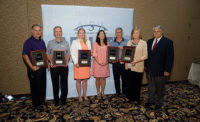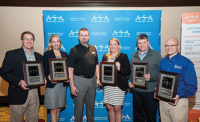Nominate your company for the ASA Safety Award
It’s time to start your ASA Safety Award application.


|
| ASA Safety Award recipients recognized at NetworkASA 2013 include, from left: T.J. Arenberg (Columbia Pipe & Supply), ASA Safety Committee Chairman Ricky Bryant (NIBCO), Ashley Martin (NIBCO), John Howe (American Pipe & Supply) and Glenn Fuller (Texas Plumbing Supply). |
We’ve all said it, or at least found ourselves thinking about it: the Empire State Building managed to get built without OSHA and it turned out just fine.
As we know, the Occupational Safety and Health Administration can be a constant reminder of the need to keep our workplace safe. And if a gentle reminder isn’t enough, a fine sure can be!
Under the OSHA recordkeeping regulation (29 CFR 1904), covered employers are required to prepare and maintain records of serious occupational injuries and illnesses using the OSHA 300 log. This information is important for employers, workers and OSHA in evaluating the safety of a workplace, understanding industry hazards, and implementing worker protections to reduce and eliminate hazards.
Employers with more than 10 employees and whose establishments are not classified as a partially exempt industry, must record work-related injuries and illnesses using OSHA forms 300, 300A and 301 (all available on OSHA’s website). Partially exempt industries include establishments in specific low-hazard retail, service, finance, insurance or real-estate and are listed in Appendix A to Subpart B. Unfortunately, plumbing wholesalers and manufacturers are not exempt.
Employers who are required to keep Form 300 (Injury and Illness log) must post Form 300A (the Summary of Work-Related Injuries and Illnesses) in a workplace every year from February 1 to April 30. Current and former employees or their representatives have the right to access their injury and illness records. Employers must give the requester a copy of the relevant record(s) by the end of the next business day.
In our September 2013 column (“How does your incident rate stack up?”),we reported on the average incident rates across various industries. During the calendar year 2011, the average incident rate among all private industries on a national basis was 3.3.
In the manufacturing sector, the national incident rate was 3.9, yet in categories similar to ASA membership the numbers were even higher. Nonmetallic mineral product manufacturing was 5.0, primary metal manufacturing was at 5.6 and fabricated metal product manufacturing had an average of 5.9 incidents.
Why is this important?
The ASA Safety Award is based on your incident rate. Manufacturers compete against manufacturers and distributors compete against distributors in three categories based on company size. That means six awards will be given out at NetworkASA 2014 in Las Vegas. Your company should be applying for these awards. There is no excuse! This is a company-wide award that is not location- or site-specific. Take this information to your COO or safety officer and ask them to apply for the ASA Safety Award.
Log onto www.asa.net/safety-resources where you’ll find everything you need to know about the awards and the OHSA 300 process, as well as archived articles, Toolbox Talks and replays of past safety webinars.
You’ve followed the rules and maintained a safe workplace, now be recognized for it. See you in Las Vegas!
HELPFUL LINKS:
Looking for a reprint of this article?
From high-res PDFs to custom plaques, order your copy today!







